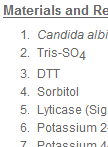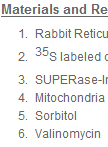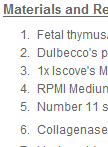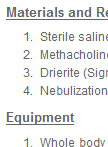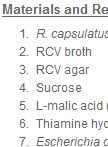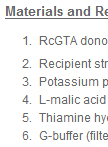Improve Research Reproducibility A Bio-protocol resource
- Protocols
- Articles and Issues
- About
- Become a Reviewer
Past Issue in 2013
Volume: 3, Issue: 4
Cell Biology
Preparation of Mitochondria from Candida albicans
Based on the methods of (Daum et al., 1982) and (Hewitt et al., 2012), we have established the use of Candida albicans as a new model system to study mitochondrial biogenesis. This dimorphic yeast provides an excellent system to investigate the coordination of mitochondrial biogenesis with other cellular networks including cellular metabolism and the cell cycle. Unlike the model lab yeast Saccharomyces cerevisiae, which has been widely used in the mitochondrial biogenesis field, C. albicans is not subject to the Crabtree effect, hence grows aerobically in glucose when oxygen is present. Therefore the control of mitochondrial biogenesis in C. albicans is more typical of eukaryotic cells. C. albicans has a fully sequenced genome and there are many published tools for genetic manipulation facilitating Systems Biology approaches. The isolation of mitochondria as described in this protocol produces a more simplified system that can be interrogated using the standard tools of molecular biology. In addition the import of radiolabelled proteins as described in the protocol: Candida albicans Mitochondrial Protein Import Assay (Hewitt et al., 2013) is a sensitive technique that can be used to determine details of kinetics and interactions of imported proteins.
Candida albicans Mitochondrial Protein Import Assay
We have established the use of Candida albicans as a new model system to study mitochondrial biogenesis. This dimorphic yeast provides an excellent system to investigate the coordination of mitochondrial biogenesis with other cellular networks including cellular metabolism and the cell cycle. Unlike the model lab yeast Saccharomyces cerevisiae, C. albicans is not subject to the Crabtree effect and hence grows aerobically in glucose when oxygen is present. Therefore the control of mitochondrial biogenesis in C. albicans is more typical of eukaryotic cells. C. albicans has a fully sequenced genome and there are many published tools for genetic manipulation facilitating Systems Biology approaches. The isolation of mitochondria (as described in the protocol: Preparation of Mitochondria from Candida albicans) (Hewitt et al., 2013) produces a more simplified system that can be interrogated using the standard tools of molecular biology. In addition, the import of radiolabelled proteins described in this protocol is a sensitive technique that can be used to determine details of kinetics and interactions of imported proteins.
Immunology
Construction of NSG-CTL Mice
The NSG-CTL mouse model is a humanized mouse model that allows the generation of peripheral human immune responses, particularly CD8+ Cytotoxic T lymphocyte (CTL) responses, and serves as an effective model for studying gene-based therapies. Natural antigen-specific T cell responses in humanized mice are relatively weak and this model was developed to boost antigen specific responses, in this case to HIV, to more closely assess these responses in vivo. We have engineered human T cells that develop in these mice to express a molecularly cloned T cell receptor (TCR) specific to HIV. Cloned TCRs to any antigen can theoretically be used to study specific responses in vivo, as long as the tissue that is manipulated is of the same human leukocyte antigen (HLA) type. The modification of hematopoietic stem cells with antigen specific TCRs allows the development of mature, functional T cells in the periphery of these mice that are specific to that antigen following normal developmental processes. This model has recently been published (Kitchen et al., 2012) and this was a major modification of the Humanized Mouse BLT model published by Melkus et al. (2006). We use Non-obese diabetic (NOD)-Severe Combined Immunodeficient (SCID), common Gamma chain knockout (γc-/-)—or NSG—mice, and implant fetal thymus pieces along with genetically modified CD34+ hematopoietic stem cells (HSCs), isolated from fetal liver, under the kidney capsule to develop into a functional thymic implant. At the same time, we deplete the mouse’s bone marrow by total body irradiation and inject more modified HSCs intravenously for hematopoietic engraftment in the mouse bone marrow. This protocol outlines the procedures to process the fetal tissue, genetically transduce the HSCs using lentiviral vectors expressing a molecularly cloned T cell receptor, and perform the subcapsular kidney implant surgery.
Measurement of Airway Responsiveness on Vigil and Unrestrained Mouse
Airway hyperresponsiveness to methacholine is an important characteristic of asthma. This protocol describes how to measure airway response to methacholine in vigil and unrestraint mouse. The enhanced pause (PenH) is an index of the airway response to increasing doses of methacholine recorded by whole-body barometric plethysmography.
Microbiology
Construction of Chromosomal In-Frame Deletion Mutants in Rhodobacter capsulatus
Markerless chromosomal in-frame deletion mutants are often used to avoid polar effects, conserve antibiotic resistance markers or make multiple mutations. This protocol capitalizes on the sacB gene (lethal in the presence of sucrose), for selection against a single cross-over event, on a suicide vector (contains no Rhodobacter capsulatus compatible origin of replication). The bacterial strains, media and suicide vectors in this protocol are specific for R. capsulatus, but the concepts can be applied to other species.
Rhodobacter capsulatus Gene Transfer Agent Transduction Assay
The gene transfer agent (GTA) is a bacteriophage-like particle that transfers genomic DNA from a donor to a recipient bacterium. The Rhodobacter capsulatus GTA (RcGTA) was the first to be studied and this protocol has been optimized for RcGTA transduction, although it could be modified for other bacteria containing a GTA. The RcGTA transduction assay can be used to determine transduction efficiencies, to create gene knock-outs, or to create new strains by transferring alleles from one strain to another.


